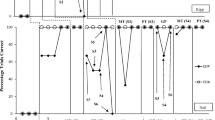Abstract
The present study replicates and extends previous research on teaching “How?” mands for information to children with autism. The experimental preparation involved mand training in the context of completing preferred activities and included training and testing under conditions when the establishing operation (EO) was present and absent. Results show that two children with autism acquired mands for information using How? only in situations where information was valuable (i.e., the EO was present); they then consistently made use of the information provided in activity completion. Generalization to novel, untaught situations was assessed.




Similar content being viewed by others
References
Carr, J. E., & Miguel, C. F. (2013). The analysis of verbal behavior and its therapeutic applications. In G. J. Madden (Ed.), APA handbook of behavior analysis (Vol. 2, pp. 329–352). Washington, DC: American Psychological Association.
Endicott, K., & Higbee, T. (2007). Contriving motivating operations to evoke mands for information in preschoolers with autism. Research in Autism Spectrum Disorders, 1, 210–217. doi:10.1016/j.rasd.2006.10.003.
Fiorile, C. A., & Greer, R. D. (2007). The induction of naming in children with no prior tact responses as a function of multiple exemplar histories of instruction. Analysis of Verbal Behavior, 23, I71–I87.
Greer, R. D., Yaun, L., & Gautreaux, G. (2005). Novel dictation and intraverbal responses as a function of a multiple exemplar instructional history. The Analysis of Verbal Behavior, 21, 99–116.
Kurtz, P. F., & Lind, M. A. (2013). Behavioral approaches to treatment of intellectual and developmental disabilities. In G. J. Madden (Ed.), APA handbook of behavior analysis (Vol. 2, pp. 279–299). Washington, DC: American Psychological Association. doi:10.1037/13938-011.
Lechago, S. A., Carr, J. E., Grow, L. L., Love, J. R., & Almason, S. M. (2010). Mands for information generalize across establishing operations. Journal of Applied Behavior Analysis, 43, 381–395. doi:10.1901/jaba.2010.43-381.
Lechago, S. A., Howell, A., Caccavale, M. N., & Peterson, C. W. (2013). Teaching “how?” mand-for-information frames to children with autism. Journal of Applied Behavior Analysis, 46, 1–11. doi:10.1002/jaba.71.
Marion, C., Martin, G. L., Yu, C. T., Buhler, C., Kerr, D., & Claeys, A. (2012). Teaching children with autism spectrum disorder to mand for information using “which?”. Journal of Applied Behavior Analysis, 45, 865–870.
Shillingsburg, M. A., & Valentino, A. L. (2011). Teaching a child with autism to mand for information using “how”. The Analysis of Verbal Behavior, 27, 179–184.
Shillingsburg, M. A., Valentino, A. L., Bowen, C. N., Bradley, D., & Zavatkay, D. (2011). Teaching children with autism to request information. Research in Autism Spectrum Disorders, 5, 670–679. doi:10.1016/j.rasd.2010.08.004.
Shillingsburg, M. A., Powell, N. M., & Bowen, C. N. (2013a). Teaching children with autism spectrum disorder to mand for removal of stimuli that prevent access to preferred items. The Analysis of Verbal Behavior, 29, 51–57.
Shillingsburg, M. A., Bowen, C. N., Valentino, A. L., & Pierce, L. E. (2013b). Mands for information using “who?” and “which?” in the presence of establishing and abolishing operations. Journal of Applied Behavior Analysis, (in press).
Williams, G., Donley, C. R., & Keller, J. W. (2000). Teaching children with autism to ask questions about hidden objects. Journal of Applied Behavior Analysis, 33, 627–630. doi:10.1901/jaba.2000.33-627.
Author information
Authors and Affiliations
Corresponding author
Additional information
Amber L. Valentino is now at Trumpet Behavioral Health.
Rights and permissions
About this article
Cite this article
Shillingsburg, M.A., Bowen, C.N. & Valentino, A.L. Mands for Information Using “How” Under EO-Absent and EO-Present Conditions. Analysis Verbal Behav 30, 54–61 (2014). https://doi.org/10.1007/s40616-013-0002-7
Published:
Issue Date:
DOI: https://doi.org/10.1007/s40616-013-0002-7




